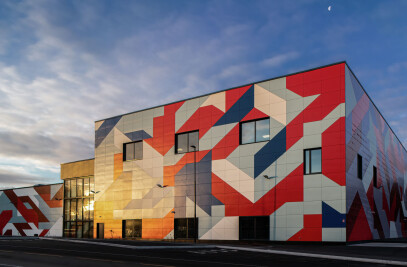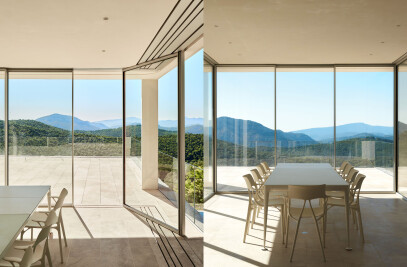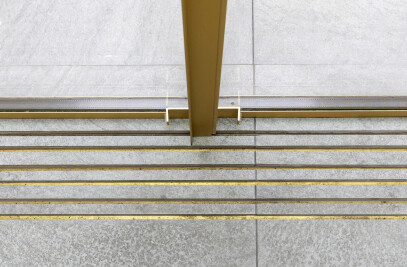London-based architectural studio Manalo & White has completed a new classroom building for Heathlands School in St Albans, south-eastern England, the UK’s largest school for deaf children. Designed in collaboration with deaf architect-led studio Richard Lyndon Design, the classroom building provides a tailor-made and supportive learning environment for pupils.
It was important from the outset that all aspects of the new classroom building should be deaf-friendly. Students at Heathlands School took part in a workshop with the architects during the project’s early stages. The classroom building’s soft green walls and yellow accents reflect the sense of “vibrancy” and “playfulness” described by the students. The design prioritizes light and clear sight lines, providing classroom layouts that meet the needs of students; “liminal spaces” beyond the classroom building are integral to more informal learning and interaction.
“Engaging the students at the start of this project was a critical part of the process,” says Richard Dougherty, Director at Richard Lyndon Design. “Deaf people have spent their entire lives adapting to places that were not designed for them. Listening to the students’ lived experiences allowed us to strengthen their relationship with their environment. Their stories at the beginning became a creative force for the design process and generated an emphasis to provide a place that they value and feel valued in.”
The National Deaf Children's Society, a non-profit organization supporting deaf children and their families in the UK, reports that “one in four councils [in England] have no specialist teaching units for deaf children”, resulting in disparities in the support received by deaf students. In operation since 1975, Heathlands is a single site school for deaf children of all ages, providing nursery, primary, and secondary education to children from 34 local councils — the intake of students has increased over the past five years, hence the school’s need to expand its premises.
Manalo & White and Richard Lyndon Design proposed a design solution that considered ways in which the school’s campus could be developed to meet the evolving needs of its students while ensuring minimal disruption to its daily operations. The architects established a comprehensive master plan — the new classroom building sits on a previously underutilized corner of the school’s campus and marks the completion of the master plan’s first phase. Fundraising activities financed the project; further fundraising will help to support future phases, including the addition of accommodation for new sixth-form students and a sports hall.
The classroom building’s design acknowledges and responds to the sensory needs of its students: efficient, simple, and flexible, it consists of six classrooms and an outdoor teaching area linked to the wider playground.
The building’s exterior is clad in green-colored fiber-cement panels with a uniform grid of wooden battens. The green exterior provides the building with a distinct identity while also harmonizing with the surrounding landscape. The use of yellow accents on windows, door frames, stairs, and rails assist with wayfinding — strong visual cues greatly enhance the site’s navigability for deaf people, for example, by helping to easily identify entry points when walking and signing.
Manalo & White and Richard Lyndon Design created a two-story building without the need for access corridors. The architects observed that such corridors “would be physically restrictive to students requiring BSL [British Sign Language] to communicate while moving between classrooms.”
Primary education is located on the building’s ground floor with secondary education on the first floor. A new link bridge connects the building’s first-floor classrooms to an existing art block; a new courtyard provides a covered link at ground-floor level. Newly paved areas connect and activate playground spaces around the edges of the campus.
The architects ensured that sight lines have been optimized to aid reading of the space; the specification of carpets and acoustic linings or panels help to improve acoustics for students with hearing aids and cochlear implants.
Richard Dougherty’s expertise in communication among deaf people together with the design principles of DeafSpace (an architectural and design initiative focused on creating accessible and inclusive environments for deaf people) guided the layout of the classrooms. Here, an orthogonal layout accommodates a deaf-friendly horseshoe desk arrangement: pupils in small classes of six to eight face one another and the teacher — this pedagogical method encourages real-time interaction and collaboration.
The use of color is also a highly effective tool that improves the legibility of visual communication and reduces eye strain when conversing in sign language. The architects explain: “In the classrooms, interiors are painted in a soft blue to offer a clear contrast between the background and the facial/signing expressions of classroom users. As background colors, soft blues and greens have been proven to complement and contrast effectively with a wide variety of skin tones, aiding communication as well as contributing to a tranquil atmosphere.”
On the first floor, vaulted ceilings with roof lights and large east-facing windows ensure classrooms enjoy ample daylight and avoid glare. The inclusion of smaller windows provides students with a range of views and allows for cross-ventilation. Natural Ventilation with Heat Recycling (NVHR) units in each classroom support window openings, improving energy efficiency and comfort levels. The building is fitted with rooftop photovoltaic panels.
Reflecting on the project, Lesley Reeves Costi, Co-Headteacher at Heathlands School, says: “At Heathlands deafness is part of everyone's identity and children thrive here. We now have a deaf-designed and deaf-friendly building which supports our teaching. It is amazing the difference that tiny details make and how welcoming the school feels for everyone.”
The new classroom building was unveiled in time for the school’s 2024 autumn term.

























































